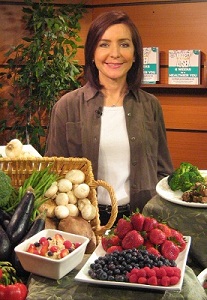How to Eat Healthy: Secrets from a Former Biggest Loser Nutritionist
 Monday, January 30, 2012 at 1:00AM
Monday, January 30, 2012 at 1:00AM  By Sandy Hu
By Sandy Hu
As the nutritionist on the NBC-TV’s Biggest Loser reality TV show, Cheryl Forberg helped contestants shed thousands of pounds a year over the past 12 years. She left the show after this season to concentrate on her private practice in the San Francisco Bay Area and on building a studio kitchen for her TV cooking demos. I’ve known Cheryl for many years as a fellow member of Les Dames d’Escoffier International.
While we are still feeling virtuous about our New Year diet resolutions, I asked my dietitian friend for advice on staying on track to ensure a lifetime of healthy – and tasty – eating.
Cheryl is the perfect advisor, with impressive culinary and nutrition credentials. She graduated from the California Culinary Academy and apprenticed at top restaurants in France. Having earned a degree in Nutrition and Clinical Dietetics and an RD (registered dietitian) credential from the University of California at Berkeley, she became a research dietitian at Cedars Sinai Medical Center in Los Angeles. Cheryl’s career also includes being on the opening team of Wolfgang Puck’s Postrio in San Francisco and serving as the private chef for Lucasfilm, Ltd., in Northern California.
Inside the Biggest Loser
Of course, first I was interested to know more about Cheryl’s role on the Biggest Loser. “At the beginning of each season, thousands would apply to be on the show,” Cheryl explained. “The casting people culled the number to 60 or 70. The finalists were flown to LA for comprehensive physical and psychological testing.” Once the cast was selected, Cheryl would introduce them to their individually tailored calorie budget, an eating plan for the show. “We discussed food journaling, portion sizes, shopping, menu planning and healthy cooking. The contestants sent me their food journals every single day. And I analyzed them every day to be sure they were meeting calorie needs, while getting enough calcium, protein and other nutrients.”
How did Cheryl get “discovered” for the Biggest Loser? “I was working in LA on a research project at UCLA and I was developing recipes for low-carb breads. A physician who knew the dietitian I was working with was putting together a pilot for a weight loss show. She introduced me and I was at right place at the right time," she said.
How to Improve your Diet
What’s the most dramatic thing you can do to improve your diet, I asked. “The very easy thing to remember is a huge step: no more white stuff. No white sugar, rice, pasta, flour. Stick to whole grains and less processed food,” she advised.
Here are some healthy tips to practice this year from Cheryl.
- “Move more. People think they’re exercising when they walk the dog or walk with a girlfriend,” she said. And while it is exercise, Cheryl says you need to challenge yourself; mix up your exercise routine and push yourself to do a little more, try a little harder.
- Eat more vegetables. Most people aren’t eating enough.
- Know how many calories your body needs. If you don’t know, you could be way off track on how much you can consume.
- Don’t skip meals. Skipping meals doesn’t lead to weight loss; it leads to weight gain.
- Think beyond weight loss to weight maintenance. Once they lose weight, a lot of people don’t know how to keep it off.
- Focus on the quality of your calories, such as lean proteins, whole grains, loads of fresh fruits and vegetables, and good fats – olive oil, nuts, seeds, avocado, fish oil.
- When cooking, keep it simple and economize on your time. You can use simple cooking techniques if you understand the importance of flavors. Learn how to use herbs and spices. If you’re intimidated and don’t know what to do, there are great spice blends to make it easy. Perk up flavor by adding acids like lemon juice, different vinegars or lime. For other good seasoning choices, check out Lori’s post on Special Fork.
- A simple technique is to layer on the flavor. Grilling is a low-fat, high-flavor technique. Or add flavor-rich ingredients such as fire-roasted tomatoes or a little grated Parmesan cheese. Think umami.
- Use healthful cooking techniques include roasting, braising, steaming, poaching and grilling. Avoid frying.
“My one New Year’s wish for everyone is to take a little time to master a few simple dishes. Cooking well doesn't have to take a lot of time and you don’t have to be a star chef.” Cheryl said.
Follow us on Facebook and Twitter for a chance to win Cheryl’s book. Flavor First: Cut Calories and Boost Flavor with 75 Delicious, All-Natural Recipes, published by Rodale Books (c. 2011).
Special Fork is a recipe website for your smartphone and PC that solves the daily dinnertime dilemma: what to cook now! Our bloggers blog Monday through Friday to give you cooking inspiration. Check out our recipe database for quick ideas that take no more than 30 minutes of prep time. Join the conversation on Facebook and follow us on Twitter.
Related posts:
Reader Comments